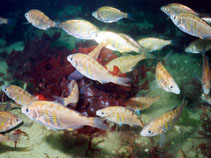| Family: |
Embiotocidae (Surfperches) |
| Max. size: |
20.3 cm TL (male/unsexed); max. reported age: 9 years |
| Environment: |
demersal; brackish; marine; depth range 1 - 146 m, non-migratory |
| Distribution: |
Eastern Pacific: Wrangell, southeastern Alaska to Bahia San Quintin, northern Baja California, Mexico. |
| Diagnosis: |
Dorsal spines (total): 8-11; Dorsal soft rays (total): 19-22; Anal spines: 3-3; Anal soft rays: 22-25; Vertebrae: 33-37. Distinguished by the rather deep, compressed body, the large scales, and the three spines in the anal fin (Ref. 27547). Lateral line slightly arched, complete (Ref. 27547). Generally silvery, with back dusky to greenish; middle of sides toward head are scales with groups of fine black dots on them, forming about eight longitudinal stripes; the stripes are often interrupted, especially in females, by three pale yellow, vertical bands; paired fins colorless; dorsal and caudal fins plain or dusky; anal fin usually colorless, sometimes with a yellow blotch toward the front (Ref. 27547). Breeding males may be almost solid black and develop fleshy lobes on both sides of anal fin (Ref. 27547). |
| Biology: |
Usually in shallow water, around eelgrass beds, piers and pilings and commonly found in bays and quiet back waters (Ref. 2850). Also in calm areas of exposed coast (Ref. 2850). Enter estuaries and brackish waters (Ref. 114138) [noted from freshwaters in Ref. 2850, but it is unlikely or rarely]. Found in loose schools or aggregations (Ref. 2850, Ref. 114138). Young feed mainly on copepods, while adults eat various small crustaceans, mollusks, and algae (Ref. 27547). Viviparous, female carries the developing young (Ref. 205). Exhibit seasonal onshore-offshore movements (Ref. 27547). |
| IUCN Red List Status: |
Least Concern (LC); Date assessed: 04 March 2019 Ref. (130435)
|
| Threat to humans: |
harmless |
Source and more info: www.fishbase.org. For personal, classroom, and other internal use only. Not for publication.
